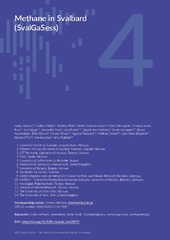| dc.contributor.author | Hodson, Andrew | |
| dc.contributor.author | Kleber, Gabrielle Emma | |
| dc.contributor.author | Platt, Stephen Matthew | |
| dc.contributor.author | Kalenitchenko, Dimitri Stanislas Desire | |
| dc.contributor.author | Hengsens, Geert | |
| dc.contributor.author | Irvine-Fynn, Tristram | |
| dc.contributor.author | Senger, Kim | |
| dc.contributor.author | Tveit, Alexander Tøsdal | |
| dc.contributor.author | Øvreås, Lise | |
| dc.contributor.author | ten Hietbrink, Sophie | |
| dc.contributor.author | Hollander, Jamie | |
| dc.contributor.author | Ammerlaan, Fenna | |
| dc.contributor.author | Damm, Ellen | |
| dc.contributor.author | Römer, Miriam | |
| dc.date.accessioned | 2025-04-24T10:35:59Z | |
| dc.date.available | 2025-04-24T10:35:59Z | |
| dc.date.issued | 2025-01-20 | |
| dc.description.abstract | Methane is a powerful greenhouse gas whose emission into the atmosphere from Arctic environments is increasing in response to climate change. At present, the increase in atmospheric methane concentrations recorded at Ny-Ålesund and globally threatens the Paris Agreement goal of limiting warming to 2 degrees, preferably 1.5 degrees, by increasing the need for abatements. However, our understanding of the physical, chemical and biological processes that control methane in the Arctic are strongly biased towards just a few lowland sites that are not at all like Svalbard and other similar mountainous, ice-covered regions. Svalbard can therefore be used to better understand these locations. Svalbard’s methane stocks include vast reserves of ancient, geogenic methane trapped beneath glaciers and permafrost. This methane supplements the younger, microbial methane mostly produced in waterlogged soils and wetlands during the summer and early winter. Knowledge about the production, removal and migration of these two methane sources in Svalbard’s complex landscapes and coastal environments has grown rapidly in recent years. However, the need to exploit this knowledge to produce reliable estimates of present-day and future emissions of methane from across the Svalbard landscape is now paramount. This is because understanding these quantities is absolutely necessary when we seek to define how society must adjust in order to better manage greenhouse gases in Earth’s atmosphere. | en_US |
| dc.identifier.citation | Hodson A, Kleber GE, Platt SM, Kalenitchenko D, Hengsens, Irvine-Fynn T, Senger K, Tveit AT, Øvreås L, ten Hietbrink S, Hollander, Ammerlaan F, Damm E, Römer M: Methane in Svalbard (SvalGaSess). In: Runge E, Neuber R, Łupikasza E, Hübner, Holmén K. The State of Environmental Science in Svalbard
– an annual report, 2025. Svalbard Integrated Arctic Earth Observing System (SIOS) | en_US |
| dc.identifier.cristinID | FRIDAID 2359211 | |
| dc.identifier.doi | 10.5281/zenodo.14425571 | |
| dc.identifier.isbn | 978-82-93871-14-9 | |
| dc.identifier.issn | 2535-809X | |
| dc.identifier.issn | 2535-6321 | |
| dc.identifier.uri | https://hdl.handle.net/10037/36934 | |
| dc.language.iso | eng | en_US |
| dc.publisher | Svalbard Integrated Arctic Earth Observing System | en_US |
| dc.relation.projectID | Norges forskningsråd: 322387 | en_US |
| dc.relation.projectID | Norges forskningsråd: 343293 | en_US |
| dc.relation.projectID | EU – Horisont Europa (EC/HEU): 101086541 | en_US |
| dc.relation.projectID | Norges forskningsråd: 326285 | en_US |
| dc.relation.projectID | Norges forskningsråd: 325610 | en_US |
| dc.relation.projectID | Norges forskningsråd: 296012 | en_US |
| dc.rights.accessRights | openAccess | en_US |
| dc.rights.holder | Copyright 2025 The Author(s) | en_US |
| dc.rights.uri | https://creativecommons.org/licenses/by/4.0 | en_US |
| dc.rights | Attribution 4.0 International (CC BY 4.0) | en_US |
| dc.title | Methane in Svalbard (SvalGaSess) | en_US |
| dc.type.version | publishedVersion | en_US |
| dc.type | Research report | en_US |
| dc.type | Forskningsrapport | en_US |


 English
English norsk
norsk
